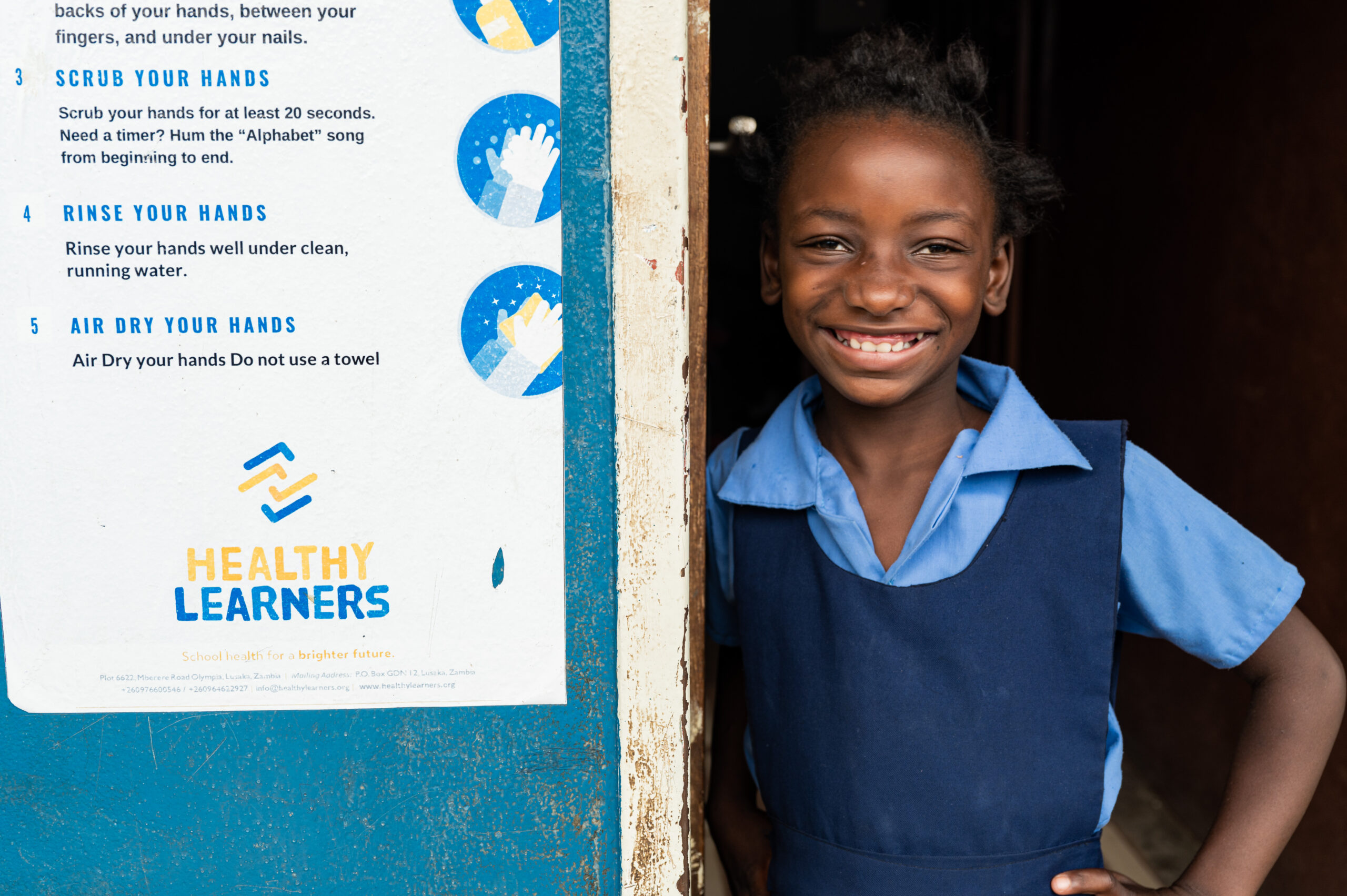Improve school-aged children’s health and educational outcomes
Lesson Learned:
In parts of the world with limited healthcare infrastructure, school-based programs that engage teachers can increase access to basic healthcare and help prevent absenteeism due to preventable sickness. Such programs can serve as a model for government support.
Zambia has one of the youngest populations in its region and globally: according to UNICEF, 53.4% of its population is under the age of 18 and the estimated median age is only 16.7.[1] But the lack of healthcare infrastructure makes it difficult for schoolchildren to access basic healthcare. For example, even when there is a healthcare clinic, wait times can be long, causing children to have to miss school to receive care.
Healthy Learners makes preventative and curative healthcare more accessible to school-aged children by moving the access point for care to schools.
“The school health program is going on very well and has helped the learners to access medical services. Previously, when learners fell sick at school, they were sent home. Now, with the establishment of the health room and school health teacher training, children get quick help from the health facility. This has helped the learners regularly attend school, and as such, we have experienced a reduction in absenteeism. This is good for our school.”
Pauline Ngalande, School Health Worker
“Learners are happy with the program and want it to continue. In the past, we had a lot of girls stay away from school due to menstrual problems, but now that we have a health room and first aid kits, we are able to help the girls. Now, they do not miss class.”
– Lucky Mukwasa, School Health Worker

What It Does
Founded in Zambia in 2015, Healthy Learners trains teachers as community health workers to screen, counsel, and provide basic care for the children in their schools. The organization partners with local clinics to train six to ten teachers per school it serves through an intensive two-week program. These teachers, or School Health Workers (SHWs), monitor student health, coordinate with local clinics, provide preventative care, and deliver “health talks” in all classes.
Using a mobile application on provided tablets, when a child is sick, SHWs clinically assess and provide responsive, automated age- and weight-specific treatment plans and follow-up recommendations aligned with World Health Organization guidelines. When an SHW cannot provide the required level of care, the student is referred and fast-tracked for care at a local government clinic. SHWs also provide preventative care, such as deworming and vitamin A supplementation, to all students on a regular schedule.
Healthy Learners also gives health talks and teaches faculty members how to do so. Because SHWs collect data on the health of the children in their schools through the app, Healthy Learners provides a curriculum tailored to local disease trends and can identify outbreaks as they happen.
Healthy Learners has served over 830,000 students — about 25% of Zambia’s public primary school population. In 2022, it signed a Memorandum of Understanding with the Zambian Ministries of Health and Education to scale the program nationally over the next three years.
How effective It Is
In a matched control study, Healthy Learners increased the proportion of students receiving deworming by 48% and vitamin A supplementation by 47% compared to a control group. Communities served by SHWs have seen a significant decrease in endemic infections.[2] For example, one township the organization analyzed had a 60% reduction in schistosomiasis, a disease caused by parasitic worms that can cause children to develop anemia, malnutrition, and learning difficulties.[3]
For an annual cost of $1.51 per student, less than 1% of what Zambia’s Ministry of Education spends per primary school student, Healthy Learners increases access to essential prevention and treatment services, with decreased absenteeism at nearly all partner schools.
How philanthropy helps
Healthy Learners receives 90% of its funding from philanthropic sources, with the rest from the Zambian government. Philanthropic support covers training and paying teachers; constructing health rooms on school campuses; and purchasing the tablets and technology that is used by the teachers. Learn more at https://www.healthylearners.org/.
More ways to help
Lwala Community Alliance uses a community health model to improve child and maternal health outcomes in Lwala, Kenya. VillageReach supports community health workers in sub-Saharan Africa with essential communication and supply chain logistics. Yamba Malawi reduces child poverty in Malawi by supporting the households of their caregivers.
For more on community-based health initiatives, see our Community-Based Approaches to Health guidance.
Notes
[1] UNICEF. (n.d.). Children in Zambia | UNICEF Zambia. Retrieved June 21, 2023, from https://www.unicef.org/zambia/children-zambia
[2] Wei, D., Brigell, R., Khadka, A., Perales, N., & Fink, G. (2019). Comprehensive school-based health programs to improve child and adolescent health: Evidence from Zambia. PLoS ONE, 14(5), e0217893. https://doi.org/10.1371/journal.pone.0217893
[3] Centers for Disease Control and Prevention. (2020, September 18). CDC – Schistosomiasis—FAQs. https://www.cdc.gov/parasites/schistosomiasis/gen_info/faqs.html
